In the future, people are born with a biological clock underneath their skin. Once they turn 25, they have one more year to live, except that time is now the new currency, and only a special few get more time than they deserve. Such is the premise of Andrew Niccol’s In Time, and, like his other films, Gattaca, S1m0ne and Lord of War, the director relied on subtle and invisible effects to help tell the story. We speak to soho VFX, responsible for the glowing green body clocks indicating how much precious life remains with each character, and to Luma Pictures who brought the bleak future to the film’s environments.
– Above: watch a breakdown of Soho and Luma’s vfx for ‘In Time’, courtesy of our media partners at The Daily.
Soho VFX imprints time
The digital-like clocks seen on the arms of the film’s future-world inhabitants – including main characters Will Salas (Justin Timberlake) and Sylvia Weis (Amanda Seyfried) – were created by soho VFX in Toronto, under visual effects supervisor Jorge Razon. “The whole point is that it just doesn’t look like a glowing tattoo on top of your skin,” notes Razon. “You need to feel like it’s underneath your skin and subcutaneous.”
soho created tests for the director using their own staff members as stand-ins. “We took a camera and shot our own arms, and messed around with different looks for the clock,” says Razon. “We tried doing simple solutions where we just projected the clock on the arms, but that wasn’t enough – it didn’t stick to the skin – so we actually did multiple layers of sub-surface scattering of the clock, and mixed it also with different layers of skin to create at least six layers of passes. The big challenge was to make it look like it was underneath your skin, and glow as well. So in further shots from the camera, the challenge was making it legible and making it feel like it was underneath your skin at the same time.”
On set, actors occasionally wore a hand rig with LED lights that had a small battery back, which would illuminate the surrounding area the arm. soho therefore had to firstly clean up the plates containing LED rigs, often replacing much of the forearm with a completely digital one before adding the clock. PFTrack was used to do multiple levels of tracking. “First, we needed to track the camera depending on the complexity of the scene,” explains Razon. “Then we needed to track the object, and then the deformation of the arm, because that’s how it differs from just dropping in a regular CG element into a scene, which would normally just require a tracked camera. In this case, we did a three-stage tracking – the camera, the object and then we needed to make sure our clocks also deformed along with the actor’s forearm.”
After that, for each shot it was determined how much of the original arm and skin needed to be replaced. CG arm and skin renders were created in Maya, and, along with the clock passes, brought into Nuke. Says Razon: “In some cases, not all, we would use some of the geometry we have in Maya and re-project those passes in Nuke to give us complete control over what those elements may look like, once it’s on top of the plate.”
“What helped us a lot,” adds Razon, “was being able to use part of the plate and our own skin textures and the actors’ skin textures that we took reference photos of. Since we were able to bring in the actors’ forearm geometry into Nuke, we were able to blend it in, along with the plate and the textures, and the different sub-surface scattering passes we had. We were able to manipulate them specifically for different shots depending on the lighting. If it was really bright or really dark, we would use different passes to determine how that would affect the clock in the shot.”
For one particular shot of Will Salas swimming in the sea, the usual process of painting out the LED rig was made more difficult from the warping happening underwater. “So for these shots we created a CG arm that would replace the original arm that was there on the plate,” says Razon. “We would simulate water to make it seem like it was underwater, and we would do our whole arm process of rendering the different sub-surface passes and mixing it in with the skin. We were also able to generate CG smoke and bubbles that would make it look like what the plate had.”
The clock itself – which was shown either constantly counting down, or shown rapidly adding or subtracting as time in years, weeks, days, minutes and seconds is transferred – was developed by soho as an element in Nuke. “If we needed to transfer time or subtract time,” says Razon, “our artists would have control over what they needed to do in order to do that. Most of the timing involving what the clocks were doing were pretty much part of the story line, and editorial gave us specific times we had to follow.”
See the layers that make up the underwater clock shots.Artists rendered about 16 passes for the clock shots, made up on varied skin patterns and pores, sub-surface passes of clocks at different skin depths, mattes to control passes in Nuke and, finally, passes for veins, subdermal skin patterns and hair. “If there was interactive glow,” notes Razon, “or if we needed to replace the whole forearm, then we would have to render some additional light passes to re-create the CG arm. And depending on the shot, we’ve also done some additional glows and creative keying to integrate the clock better in Nuke.”
To accommodate integration of the clock down the line, most of the main actors in the movie had their forearms shaved. “Whenever possible, we would take a key of the skin texture along with the hairs and layer it back on top of the numbers,” explains Razon. “Doing so allowed us to have control over how much of the clock we are revealing under the skin and hair. However, there were a few shots in the movie that required us to add some CG hairs back on top of the arm.”
As part of its total contribution of 195 shots, soho also delivered visual effects for the Jaguar chase in the film, doing rig removals on seatbelts and rollbars, and adding bending metal, smoke and debris as the car tumbles down into the LA River. Along with the clock shots, these effects were conceived as subtle additions which stayed true to Andrew Niccol’s directing style. “That was how we and the whole production approached the film,” comments Razon. “For example, initially when they were shooting the footage, say for test shots, they had really bright LED lights and they realized that was not really the main focus of the film and it should be more subtle. The clock shots were almost just set dressing, rather than the main focus.”
Luma enhances the landscape
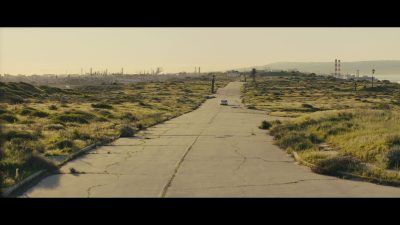
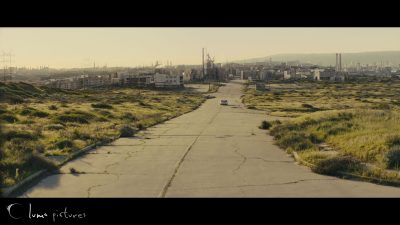
Luma Pictures continued the invisible effects theme on In Time, with 65 shots ranging from matte paintings, set extensions and CG enhancements. Having worked with In Time DoP Roger Deakins on several recent Coen Brothers films, the studio came in at the cinematographer’s request to augment a number of scenes, including those filmed in an older neighborhood adjacent to LAX that serves as the ghetto area in the story.
“A lot of the shots were looking out at the ocean,” adds Johnson, “so Roger joked that the ocean and the sky was just a big bluescreen for us – and we had to replace that with more wasteland and rolling hills and abandoned roads.”
Ultimately, Luma filled in the backgrounds and buildings with a mix of mostly 3D and some 2D matte paintings. Notes Johnson, who was also on set for 22 days of shooting: “A lot of the time we had to pretend there was a bluescreen or greenscreen behind the actor. Any time they are running behind a background, you do lose all the edge detail behind them – the edge transparency – so they have to be replaced with paint and roto.”
Set extension work included various shots of the industrial and upscale city areas, the establishing shot of the casino that Salas visits, along with the wide shot of the mansion seen when he and Weis skinny dip in the ocean, and stairs for mansion itself. For the film’s final scenes near the wasteland, Luma added a distant urban cityscape and mid-ground industrial warehouses. The wasteland also required decrepit buildings, broken roads, plant growth and palm tree removal.
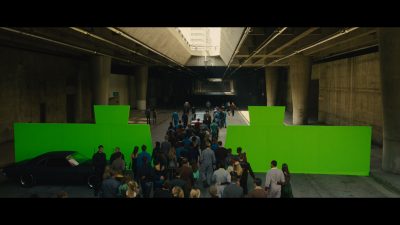
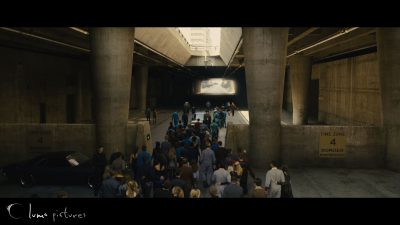
In an earlier sequence, Salas launches a limousine through one of the time zone toll booths, necessitating some effects work from Luma. “They constructed the booths near the Sixth Street Bridge in downtown LA,” says Johnson. “They did all the stunt work for the car chases there. As the car goes through the toll booth there was a lot of balsa wood that goes flying everywhere, and they wanted it to look much more substantial, so we added some Maya particle-type smoke and concrete chunks and wood splinters, and a tollbooth time zone sign. It was dynamically simulated and hand-animated as well to add to the destruction.”
Rounding out Luma’s visual effects work were some billboard and large monitor replacements, a composite of the armored truck crashing through the bank windows and some wire and crew removals and street clean-ups. For Johnson, who has had experience more recently with large-scale CG work on films such as Thor, his time on In Time offered the chance to return to effects of the invisible kind. “It really comes down to matching what’s in the plate,” he says, “More so than being purely creative from a freeform standpoint. You always have that foundation of what the plate is, so you’re matching the colors to the plate, matching intensities and values, and if you can match them perfectly, it becomes invisible and part of the plate.”
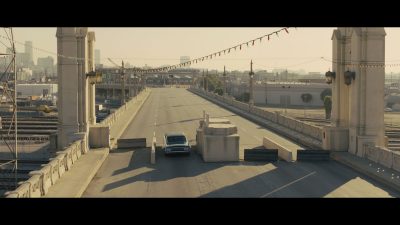
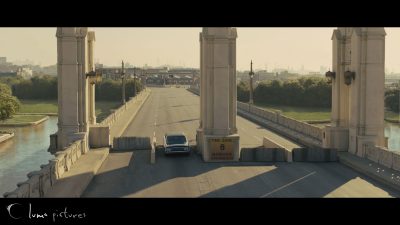
“And working with director Andrew Niccol, too, the thing with his films is that his style is very minimalistic and it was fairly easy to nail down what he did and didn’t like,” says Johnson. “Once we realized he didn’t like anything flashy that would stand out, then it was more about not letting any of the effects get in the way of the story. Actually, a lot of the notes from Andrew were story-driven – ‘how does this affect the plot at this point in the film?’ – rather than on the technical aspects of the shot.”
Images and clips copyright © 2011 20th Century Fox.

Those are some really nicely done green screens! Looks like very solid vfx work!
I think they may have done some cleanup on the greenscreen plate and released that for whatever reason. Looks good though.
Interesting movie.